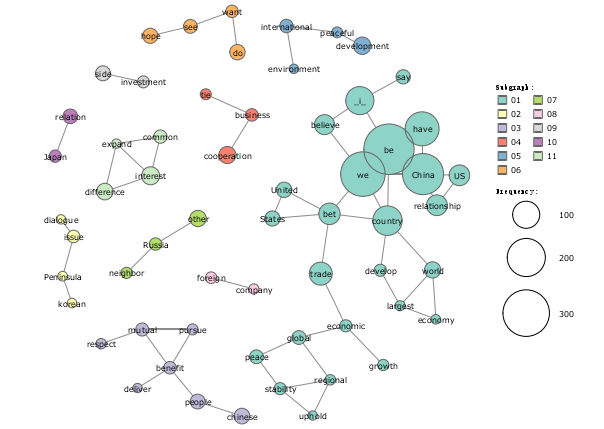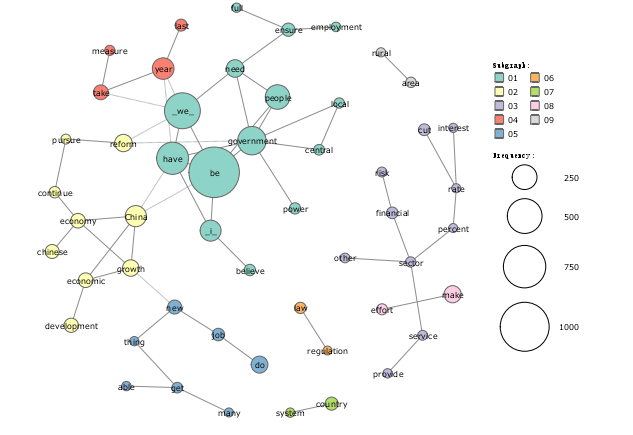1 Introduction
1.1 Research Background
National image mainly constructed by self-shaping and other-shaping is considered to be an important intangible asset of a country, which is a manifestation of a country’s comprehensive national strength and international status. Since China’s reform and opening up, China’s international influence has also expanded. As a rising country, shaping a good national image has become an important part of the national development strategy.
The Chinese Premier’s Press Conference (the CPPC) is held in Beijing each year towards the conclusion of the “two sessions”. During the Conferences, the Premier will answer the questions from the journalists at home and abroad. CPPC provides a rare and vital avenue for China’s top leadership to communicate with the outside world and to engage with an international audience on various topical issues. Therefore, it is such a discursive event that provides a vital platform for China to articulate its discourse.
The new Party leadership has been increasingly paying attention to image construction and put forward the “proper telling of China’s story”. However, a large number of domestic studies have been carried out from the perspective of communication and international politics based on news discourses. Besides, the other-shaping image has become the main focus of attention, and this kind of research often neglects self-shaping image. Only by shaping the domestic image (self-image) well can we better disseminate the international image of China. Therefore, exploring the discursive construction of national image at the interpreted CPPC based on discourse-historical approach will help to construct the discourse expression of Chinese image and make the construction of national image come true.
.................................
1.2 Research Objectives and Research Questions
This research aims to analyze the discursive construction of China’s image in the interpretation of Premier Li Keqiang’s answering remarks from 2013 to 2019 from the perspective of discourse-historical approach based on the following three questions.
(1) What China’s national image is constructed at a macro-level at the interpreted Chinese Premier’s Press Conferences?
(2) How nomination, predication and argumentation strategies are linguistically realized to construct China’s national image at micro-levels?
(3) What factors affect constructing China’s national image?
This research will make up for the deficiency of linguistic study on national image construction. Besides, in order for China’s discourse to carry discursive power and effect change on a regional and international scale, its interpretation is of great importance. This research can gain interpreters’ awareness to precisely interpret the linguistic resources in Chinese version as they can greatly promote China’s national image.
............................
2 Literature Review
2.1 National Image
As for “image”, Longman Dictionary of Contemporary English defines it as “the opinion people have of a person, organization, product etc., or the way a person, organization etc. seems to be to the public; a picture that you have in your mind, especially about what someone or something is like or the way they look”[1]. The English definition shows that the two are similar, but not equivalent, and the latter can be reproduced through material or psychological media. From this perspective, Western scholar Philip Kotler puts forward the widely recognized definition of “image”, that is, “people’s beliefs and impressions about a certain object”[2]. It can be seen from this that “image” is people’s subjective perception of the object it represents. According to this definition, we can interpret national image as the image of a country that is, the cognition, belief, impression, etc. of the country. However, after consulting the relevant literature, it is found that the concept of national image is not clearly defined.
In 1956, Boulding[3] first proposed the term in National Images and International System. He believes that national image refers to a country’s cognition and understanding of itself, as well as the cognition of other actors in the international system. He also proposes that the image of a country has three dimensions which are geographical space, physical strength and psychological attitude. Geographical space refers to the natural geographical image of a country, that is, the natural geographical image above the natural form of the country. The dimension of physical strength refers to the comprehensive national strength. The third dimension talks about hostility or friendliness to the country. He further concludes that the psychological attitude dimension is the decisive factor of national image[ 4 ]. Therefore, subjective psychology combined with natural form in geographical space, information perception and dissemination and comprehensive strength are four important elements of constructing national image. Boulding has laid the foundation for the study of national image.
Martin and Eroglu[5] believe that national image construction is multi-dimensional which is based on the collective information of descriptive, inferential and informative beliefs about a certain country. Etzoni’s[6] claims that political structure, economic and military strength, culture and so on of a country play decisive roles in its image construction. As far as Jervis[7] is concerned, sometimes a desired national image can talk louder than the growth of economic or military power. According to his elaboration on national image, it can be known that the perception of national image can change people’s previous opinions or thinking set, and he emphasizes that transmitting effective information is of great importance in constructing a positive national image.
............................
2.2 Previous Studies on China’s National Image
2.2.1 Previous Studies on China’s National Image Abroad
Based on the analysis of existing documents, foreign research on China’s national image can be divided into three main research periods.
At the beginning of the 20th century, the famous American scholar Fei Zhengqing [13] takes the lead in studying China’s image. He mainly focuses on the study of China’s image of national conditions and Sino-US relations. From then on, more and more Western scholars devoted themselves to the study of China’s national image, leaving a wealth of research results. The image of China presented in this stage of research is mainly described by the observation and experience of foreign scholars who once lived in China.
In the 1950s, Harold launches a series of surveys and interviews on the image of China in the eyes of Americans, and published his monograph Scratches on Our Minds: American images of understanding about China[14]. Joshua publishes a monograph on how foreigners see China’s image in the book the country in the eyes of foreign scholars: China’s image[15]. The earliest book to study China’s national image reflected by American media is China’s Media, Media’s China written by Lee[16]. At this stage, the study of China’s image begins to focus on portrayals of China’s image in foreign media and public’s impression on China.
At the beginning of the 21st century, the study of China’s national image by western scholars has entered a new stage with the improvement of China’s comprehensive national strength and the holding of many international events in China. Pere et al[17] investigate using the 2008 Olympic Games to enhance China’s image and increase its global brand equity. Maags[18] makes a comparative study of how China enhances national image by launching China Culture Year in Europe and concludes that distinct China’s national image has been depicted through China Culture Year events. Alessandra[19] assesses the activities that Chinese actors are engaged in while presenting the country with a particular focus on the role and identity of the Chinese state. Vera et al[20] analyze whether China’s growing economic engagement in Latin America has an effect on citizens’ perceptions of China within 18 Latin American countries over the 2002-2013 period.

语言学论文怎么写
.................................
3. Theoretical Framework ................................... 11
3.1 Critical Discourse Analysis ............................ 11
3.2 Discourse-historical Approach ............................... 12
3.3 Summary ................................ 14
4. Methodology ................................... 15
4.1 Data Collection ................................ 15
4.2 Research Methods and Research Tools ................................ 15
4.3 Research Procedures ............................ 16
5 Analysis of China’s National Image Construction ....................... 17
5.1 China’s National Image Constructed in Different Topics ........................ 17
5.1.1 China’s National Image Constructed in Topics on Domestic Affairs ..... 18
5.1.2 China’s National Image Constructed in Topics on Foreign Affairs ........ 20
5 Analysis of China’s National Image Construction
5.1 China’s National Image Constructed in Different Topics
In the interpreted discourses of CPPC from 2013-2019, Chinese and foreign journalists put forward 110 questions to the premier, focusing on various domestic and foreign affairs. Among them, three questions only appeared once, and the premier only gave a brief reply when answering, so they will not be taken into account. In terms of domestic affairs, it mainly includes domestic politics with 29 questions, domestic economy with 24 questions and domestic society with 23 questions. Foreign affairs include China’s diplomacy with 18 questions and foreign economic cooperation with 13 questions. The author categorizes the questions according to the main content and key words in them, for example, if “economy” and its variants appear in the questions, they are classified as topics related to economy. After a detailed classification and examination of the questions in the discourse, it can be concluded that the interpreted CPPC discourses actively construct China’s national image in domestic affairs on three topics: domestic politics, domestic economy and Chinese society, and in foreign affairs centering on China’s diplomacy and foreign economic cooperation.
5.1.1 China’s National Image Constructed in Topics on Domestic Affairs

语言学论文参考
6 Conclusions
6.1 Major Findings
First of all, the analysis of topics in the discourses identifies what national images are constructed at the interpreted CPPC. After the investigation of the word co-occurrence network of different topics related to domestic and foreign affairs and a detailed examination of the concordance lines of some specific words, the study finds that China’s positive national image is constructed at a macro-level in domestic and foreign fronts with different topics: domestic politics, domestic economy and domestic society in domestic affairs, diplomacy and foreign economic cooperation in foreign affairs. As for domestic fronts, a responsible, capable and people-oriented government image is depicted. In foreign affairs, China is constructed as a nation adhering to peaceful coexistence, mutual respect, and mutual benefit.
Secondly, how China’s national image is positively constructed at the lexical and syntactic levels is investigated through discursive strategies and their specific linguistic realization forms. To begin with, by means of personal reference, using different self-referential subjects can gain different effects. In domestic affairs, “we”, “government” and “I” are mainly used when talking different topics. “We” and “government” are usually used to explain the policies and measures that the Chinese government has adopted and will take. Especially “government” is often used with the high-value modal verb to express the government’s high commitment to the broad masses of people. “We” is employed mainly to refer to the Chinese government or Chinese people to express the government’s views and wishes and establish a connection and empathy with the people. “I” is generally used to express premier’s experiences, ideas and state his status. In foreign affairs, the deictic expression “we” puts China and other countries into a single “group”, which shows the high commitment of China to shoulder its international responsibilities. And then, through the predicate structure and modal verbs, the positive characteristics are assigned to China. Specifically, in domestic affairs, predicate structures “have/will + (adv.) + verb” with the subject “we” and “will + (adv.) + verb” with the subject “government” show China’s positive actions in policy-taking and measure-making, which construct Chinese government as a responsible, capable and people-oriented institution. In foreign affairs, the modal verb “will” and “we” are often used together, indicating that China is committed to promoting international economic growth and win-win cooperation. In addition, topos of responsibility, topos of advantage together with topos of number reaffirm Chinese government in domestic and China in the international world as a capable and responsible power. Besides, the topoi also demonstrate the great benefits that Chinese government has brought to people at home and abroad.
reference(omitted)
